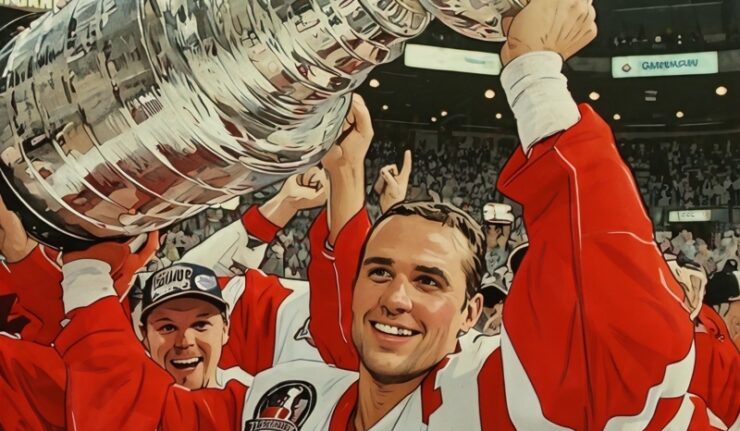It’s not every day that a piece of silverware gets treated better than royalty, but then again, not every trophy is the Stanley Cup. This storied, elegant hunk of silver—often dented, occasionally misplaced, always revered—is hockey’s holy grail, a sacred relic coveted by generations of sweat-drenched warriors on ice. To know the Cup’s journey is to understand hockey itself: unpredictable, a bit quirky, yet steeped in tradition and pride.
From Humble Beginnings: Lord Stanley’s Punch Bowl
In 1892, Sir Frederick Arthur Stanley, the 16th Earl of Derby and Governor General of Canada, attended his first hockey game. Enchanted by the speed, intensity, and passion of this curious sport on ice, Lord Stanley decided hockey deserved recognition—a tangible symbol to crown its champions. He purchased a silver punch bowl in London for ten guineas (about fifty Canadian dollars at the time), and hockey’s most revered artifact was born.
Initially dubbed the “Dominion Hockey Challenge Cup,” the trophy was affectionately—and quickly—renamed after its generous donor. The Stanley Cup began as an amateur prize, awarded first in 1893 to the Montreal Hockey Club, champions of the Amateur Hockey Association of Canada. Little did Lord Stanley imagine the wild journeys awaiting his humble punch bowl.
Evolution and Misadventure of the Stanley Cup
Over the years, as hockey shifted from amateur clubs to professional leagues, the Cup evolved. Originally a single silver bowl, rings were added to accommodate the names of champions—a tradition that became as enduring as hockey’s gritty ethos. This expansion gave rise to the towering tiered trophy familiar to fans today. Every winning team’s roster gets inscribed, eternally etched in hockey lore.
But the Cup’s journey has never been merely ceremonial. Like any great hockey legend, it has a rap sheet of misadventures. In 1905, the Ottawa Silver Seven punted it into the frozen Rideau Canal on a celebratory bender. Montreal Canadiens legend Maurice “Rocket” Richard casually left it behind after a party in 1957. It has been mistakenly abandoned at airports, rescued from swimming pools, and used as a cereal bowl. Such escapades would be blasphemous for most sports trophies, but hockey embraces these follies, knowing they add to the Cup’s mythology.
Traditions and Superstitions
No other trophy embodies the camaraderie of sport quite like the Stanley Cup. Hockey players refuse to touch it until they’ve earned the right. It’s not merely superstition—it’s respect. The Cup is a dream they chase, and dreams shouldn’t be tampered with lightly. The captain of the victorious team always hoists it first, a tradition born from instinct rather than ceremony, yet now as sacred as scripture.
Perhaps the greatest tradition, and certainly the most Canadian, is the player’s “Day with the Cup.” Every member of the winning team, from superstar captain to humble trainer, gets 24 hours of unsupervised joy with Lord Stanley’s treasure. It has attended weddings, baptisms, barbecues, and community parades. Sidney Crosby famously took it through a Tim Hortons drive-thru. Wherever it goes, it brings unparalleled joy, creating moments fans and communities cherish forever.
Naming Rights and Etched NHL History
Unlike other championships, names aren’t just recorded—they’re carved into immortality. Over 2,000 names currently adorn the Cup, each telling its own story, capturing a snapshot of history. Occasionally, humorous mishaps sneak onto the engraving, like “Jacques Plante” becoming “Jacques Plant,” or the Toronto Maple Leafs spelled “Leaes.” Mistakes are rare but beloved quirks, adding to the Cup’s rich tapestry.
Guardian of the Cup
The Stanley Cup even has its own dedicated guardian. Phil Pritchard, the white-gloved “Keeper of the Cup,” escorts the trophy around the globe, ensuring its safety. He has become a hockey celebrity himself, his appearance signaling excitement and victory. No other trophy has such an affectionate and well-known custodian—a testament to the Stanley Cup’s unique place in sports culture.
Why the Stanley Cup Matters
The Stanley Cup isn’t just a prize; it’s a living artifact. It connects generations, binding together players, families, and entire communities. It’s a beacon of perseverance, tradition, and joyful excess—a perfect mirror to hockey’s relentless spirit.
Whether lifted triumphantly above a captain’s head or serving ice cream at a family picnic, the Stanley Cup endures as the most beloved, humanized, and storied trophy in sports. It’s a reminder of hockey’s history, a bearer of dreams, and a partner in endless misadventure. Lord Stanley’s humble punch bowl, battered yet brilliant, will forever symbolize hockey’s beating heart.

